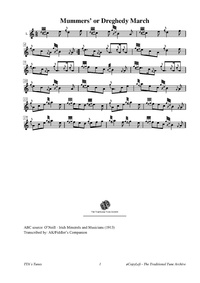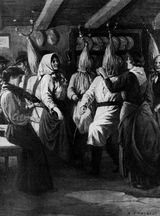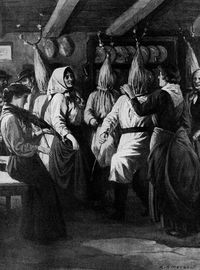Template:Pagina principale/Vetrina: Difference between revisions
No edit summary |
No edit summary |
||
| Line 1: | Line 1: | ||
{{SheetMusic | {{SheetMusic | ||
|f_track= | |f_track=Mummers March.mp3 | ||
|f_pdf= | |f_pdf=Dreghedy March.pdf | ||
|f_artwork= | |f_artwork=Irishmummers.jpg | ||
|f_tune_name= | |f_tune_name=Droghedy March | ||
|f_track_title= | |f_track_title=Droghedy March | ||
|f_section=abc | |f_section=abc | ||
|f_played_by=[https://soundcloud.com/ | |f_played_by=[https://soundcloud.com/maggiesansone Maggie Sansone] | ||
|f_notes= | |f_notes= Irish Mummers. | ||
|f_caption= | |f_caption=Then the Mummer's play commences,{{break}} | ||
|f_source=[https://soundcloud.com/ | When St. George so bold advances,{{break}} | ||
Tells of "draggins, elves, and jyants" {{break}} | |||
He has killed, and hurls defiance; | |||
|f_source=[https://soundcloud.com/maggiesansone/mummers-march Soundcloud] | |||
|f_pix=420 | |f_pix=420 | ||
|f_picpix=200 | |f_picpix=200 | ||
|f_article=[[ | |f_article=[[Droghedy March| '''Droghedy March''']] | ||
The title of the melody probably refers to Charles Moore, 2nd Viscount Drogheda who as involved in the siege of that same town in 1642. He was killed in clashes with Owen Roe O'Neill in 1643. The title may also be a corruption of the Irish word ''draiocht'', meaning magic (see note for "[[Drocketty's March]]"). | |||
<br> | |||
<br> | |||
A "Droghedy's March" from county Wexford is described by Patrick Kennedy in 1812 in his book '''On the Banks of the Boro''': | |||
'' | [[File:irishmummers.jpg|200px|thumb|left|Irish Mummers]] | ||
"[[ | |||
' | |||
'' | |||
<blockquote> | <blockquote> | ||
'' | ''The tune called Droghedy's March was occasionally danced to among the'' | ||
'' ' | ''hornpipes, by a performer furnished with a short cudgel in each hand, which'' | ||
''he brandished and clashed in harmony with the tune. But we had the good fortune'' | |||
''to see it performed in a complete fashion on the borders of the barony of Bargy,'' | |||
''in the old manor-house of Coolcul, whose young men, joined by the stout'' | |||
''servants and labourers on the farms, were well able, in country parlance, to'' | |||
''clear a fair. Amongst these the present chronicler was initiated into the'' | |||
''mysteries of mumming, and was taught to bear his part in that relic of the'' | |||
''Pyrrhic or Druidic dance, "Droghedy's March." | |||
</blockquote> | </blockquote> | ||
}} | }} | ||
Revision as of 09:47, 4 March 2023

When St. George so bold advances,
Tells of "draggins, elves, and jyants"
He has killed, and hurls defiance;
Played by: Maggie Sansone
Source: Soundcloud
Image: Irish Mummers.

The title of the melody probably refers to Charles Moore, 2nd Viscount Drogheda who as involved in the siege of that same town in 1642. He was killed in clashes with Owen Roe O'Neill in 1643. The title may also be a corruption of the Irish word draiocht, meaning magic (see note for "Drocketty's March").
A "Droghedy's March" from county Wexford is described by Patrick Kennedy in 1812 in his book On the Banks of the Boro:

The tune called Droghedy's March was occasionally danced to among the hornpipes, by a performer furnished with a short cudgel in each hand, which he brandished and clashed in harmony with the tune. But we had the good fortune to see it performed in a complete fashion on the borders of the barony of Bargy, in the old manor-house of Coolcul, whose young men, joined by the stout servants and labourers on the farms, were well able, in country parlance, to clear a fair. Amongst these the present chronicler was initiated into the mysteries of mumming, and was taught to bear his part in that relic of the Pyrrhic or Druidic dance, "Droghedy's March."
...more at: Droghedy March - full Score(s) and Annotations
X:1 T:Mummers' or Dreghedy March M:6/8 L:1/8 S:O'Neill - Irish Minstrels and Musicians (1913) Z:AK/Fiddler's Companion K:Amin V:1 clef=treble name="1." [V:1] {d/4c/4d/4}c2e {g}d2f | {d/4c/4d/4}c2e {g/4B/4d/4}B2A | {d/4c/4d/4} c2e {g}d2f | {g}ec{G}A {g/4B/4d/4}B2{G}A :| {g}e>c{G}A {g}A>{e}A{e}A | {g/4/e/4f/4}ecA {g}d2f | {g}e>c{G}A {g}A>{d}A{e}A | {g/4f/4g/4}fec {B/4d/4}B2{G}A | {g/4e/4f/4}e>c{G}A {g}A>{d}A{e}A | {g}ec{G}A {g/4B/4d/4}B2A | {g/4e/4f/4}ecA {g}A>ce | {a/4f/4}aec {g/4B/4d/4}B2{G}A | {g}Ace {a/4g/4}a2e | {g/4f/4g/4}fed {f/4e/4f/4}e2c | {g}Ace {a/4g/4}a2e | {g/4f/4g/4}fec {g/4B/4d/4}B2{G}A | {g}Ace {a/4g/4}a2e | {g/4f/4g/4}fed {g}efg | {a/4g/4}a2f {g/4f/4}g2e | {g/4f/4g/4}fec {g/4B/4d/4}B2{G}A ||
